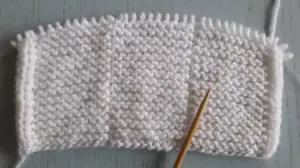How to calculate the right amount of cashmere yarn for any knitting project – Part II: Scarves and Shawls
Before reading today’s post, please read this (It’s the introductory part of what I am covering in what follows).
You’ll probably have already noticed that length is more relevant than the yarn’s weight. When someone asks me “how much wool should I buy for a scarf?”, I don’t know what to answer. It all depends on the type of wool, and even more, on the thickness of the yarn. A 50 gr ball of wool could be as long as 30 and reach up to 300 metres in length. The one 30 mt long will be thicker, the one measuring 300 mt, very fine. Here I would like to help you by simplifying the estimate.
The table below shows the approximate amount of stitches in a 10 cm stocking stitch sample, the corresponding metres of yarn needed to knit a scarf or a shawl.
Please remember these numbers represent an average, so if you have a “tight hand”, you’ll need more stitches, on the contrary, if you have a “loose hand”, you might need less.
| Approximate number of stitches in 10 cm (stocking stitch) | short scarf 15 x 100 cm (approx) | long scarf 25 x 140 cm (approx.) | shawl 50 x 280 cm (approx.) |
| 12 | 104 metres | 243 metres | 486 metres |
| 16 | 148 metres | 344 metres | 688 metres |
| 20 | 186 metres | 434 metres | 868 metres |
| 24 | 264 metres | 614 metres | 1228 metres |
| 28 | 290 metres | 676 metres | 1352 metres |
| Knitting needle size | Approximate number of stitches in a 10 cm sample (stocking stitch) |
| 2.25 – 3.25 | 31 – 26 |
| 3.25 – 3.75 | 25 – 28 |
| 3.75 – 4.5 | 28 – 20 |
| 4.5 – 5.5 | 20 – 16 |
| 5.5 – 8 | 15 – 12 |
Obviously, this data may need to be adjusted as it’s based on a sample knitted in stocking stitch. Scarves and shawls, in fact, are generally knitted using more elaborate kinds of stitches which require more yarn.
So if you choose more complex patterns (such as cable or fisherman’s rib stitch), you’ll need to consider an extra 10 – 15% of yarn.
On the Hircus Filati website, you’ll find information on the length of the yarn on sale. Hopefully it will help you make the decision on your purchase.
I can hear the next question in your head: “and what if instead of a scarf, I want to knit a hat, or gloves, or a jumper… how much cashmere would I then need?” You’ll find the answers in the next posts.
In the meantime, back to the scarf. Christmas is approaching and the festive atmosphere reminds us of presents. How many people tell me they don’t know what to give men!!!!! I agree, it’s not as easy as it is for women :-). I suggest a classic: a very precious scarf in cashmere (pure or blend) knitted especially by you. It will surely be highly appreciated!
It isn’t easy to find a pattern for a man’s scarf. Usually you use different types of cable, garter stitch, and sometimes moss stitch. I am suggesting two designs, the first is easier and for beginners, the other, a little more complex. If you wish to add a touch of elegance, make the edges in reverse stocking stitch (see samples below).
Sample 1

is made up of rows of knit garter stitch and rows of purl garter stitch. The number stitches to cast on should be divisible by 20 + 10 (for the last strip) + 6 (for two reverse stocking stitch edges)
1 strip of 10 garter stitches measures about 5 cm (size 4 – 4.5 needles)
First Row: 3 knit, 10 knit, 10 purl, repeat from * to *, 13 knit
Second Row: 3 purl, *10 knit, 10 purl*, repeat from * to *, 10 knit, slip the last 3 stitches to the right needle without knitting, leaving the yarn in front
Third Row: 3 knit, *10 knit, 10 purl*, repeat from * to *, 10 knit, slip the last 3 stitches to the right needle without knitting, leaving the yarn behind
Fourth Row: 3 purl, *10 knit, 10 purl*, repeat from * to *, 10 knit, slip the last 3 stitches to the right needle without knitting, leaving the yarn in front
repeat third and fourth rows.
Sample 2

Cast on 40 stitches (needle size 4 – 4.5)
First row: 3 knit, * strip of 8 garter stitches (= 8 knit), 1 knit, 1 purl, 1 knit, 1 purl, 1 knit, repeat from * to *, strip of 8 garter stitches (= 8 knit), 3 knit
Second row: 3 purl, * strip of 8 garter stitches (= 8 knit), 1 purl, 1 knit, 1 purl, 1 knit, 1 purl, repeat from * to *, strip of 8 garter stitches (= 8 knit), reverse stocking stitch (move the last 3 stitches to the left needle without knitting, leaving the yarn in front)
Third row: edge in reverse stocking stitch (3 knit), * strip of 8 garter stitches (= 8 knit), strip of 5 rib (= knit all the knit stitches (3) by entering with your needle into the the knit stitch under the one on the other needle, while the purl stitches will be knitted on the back)*, repeat from * to *, strip of 8 garter stitches (= 8 knit), reverse stocking stitch (slip the last 3 stitches to the left needle without knitting, leaving the yarn behind)
Fourth row: edge in reverse stocking stitch (3 knit), * strip of 8 garter stitches (= 8 knit), strip of 5 rib (= knit all the knit stitches (2) by entering with your needle into the the knit stitch under the one on the other needle, while the purl stitches will be knitted on the back)*, repeat from * to *, strip of 8 garter stitches (= 8 knit), reverse stocking stitch (slip the last 3 stitches to the left needle without knitting, leaving the yarn in front)
Repeat third and fourth rows up to the desired length.
I hope this post helps you calculate the amount of cashmere needed to make a beautiful scarf.
Have fun knitting! Look out for the next post.
Alicja Kwartnik for Hircus Filati






